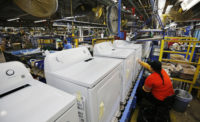STOCKHOLM—Almost 98 percent of the total waste produced at Electrolux’s manufacturing sites was either recycled or recovered in 2022, and 55 percent of the appliance manufacturer’s factories are now certified as “Zero Waste to Landfill” facilities.
A factory that is certified as a Zero Waste to Landfill facility sends less than 1 percent of its total waste to landfill and uses less than 3 percent of its waste for converting energy.
“We reduced the percentage of waste sent to landfill by 20 percent in 2022 compared with the previous year, which is an amazing result,” says Claudia Mazzon, operations sustainability specialist for Electrolux and global coordinator of the company’s Zero Waste to Landfill program. “I am so proud of the great job done by our colleagues around the world who are proactively working to reduce waste and find recycling opportunities.”
During 2022, seven additional Electrolux Group factories were certified to the Zero Waste to Landfill program. They are Santiago, Chile; Zarow, Poland; Forlì, Italy; Cairo, Egypt; Juarez, Mexico; Swidnica, Poland; and Kinston, NC. Electrolux now has zero waste facilities in Argentina, Australia, Brazil, Chile, Egypt, Italy, Mexico, Poland and the United States.
Becoming a zero waste facility often requires innovative thinking. At the company’s assembly plant in Adelaide, Australia, engineers identified waste enamel powder as a major source of waste to landfill. The team created a way to incorporate a proportion of waste powder back into the enamel powder mix. The technology avoids sending approximately 6 metric tons of waste enamel powder to landfill each year and was a key step to certifying the factory to the Zero Waste to Landfill program.
At the company’s assembly plant in Juarez, Mexico, engineers found a way to use waste heat to dry wet silica sand and reuse it in the casting process. The factor also partners with a cement company to recycle the remaining waste sand. This initiative avoids sending more than 25 metric tons of waste to landfill each year.
At the Electrolux’s assembly plant in Curitiba, Brazil, engineers struggled to find an alternative use for sealing rubber and polyurethane waste other than burning it for energy. After thorough research and trials, they partnered with a supplier to transform the waste rubber into carpets, which have also been used at the plant. Additionally, they found a supplier to reuse polyurethane waste for door and panel insulation, which helps reduce the use of virgin resources. These initiatives annually recycle approximately 100 metric tons of waste.






